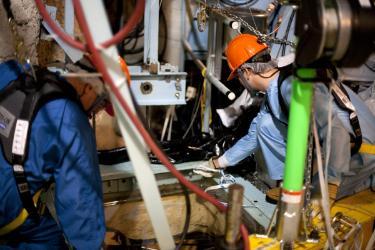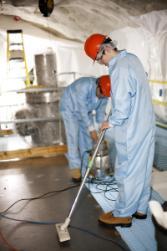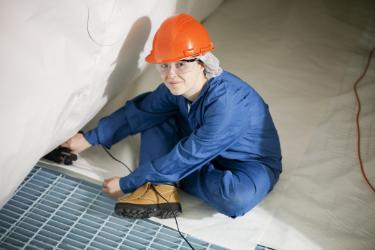The SNO+ Group at QMUL

SNO+ is a multi-purpose low energy neutrino experiment, currently under construction in SNOLAB in Sudbury, Canada. The experiment inherits the successful Sudbury Neutrino Observatory (SNO) detector, with the original heavy water target replaced with liquid scintillator. This allows the detection of much lower energy neutrinos and opens the door to a rich neutrino physics programme. The Queen Mary SNO+ group is involved in many areas of the experiment specialising in software, analysis and development of optical and radioactive calibrations.
The main goals of SNO+ are to:
- Search for neutrino-less double beta decay. This process is a golden-channel to test whether the neutrino is a Majorana particle that can essentially act as its own antiparticle. If observed it would also tell us about the absolute neutrino mass scale. SNO+ will deploy a large quantity of Tellurium 130 in the scintillator volume to perform this measurement.
- Measure the low energy components of the solar neutrino energy spectrum. In particular, measure the flux of neutrinos produced by the pep interaction in the Sun. No other experiment can observe this signal due to C11 background events, but these aren't a problem in SNO+, which is well shielded from this background due to its location 2km underground in the Vale Creighton Nickel mine. Accurately measuring the pep flux will allow us to test neutrino oscillation models and search for new physics processes.
- We can also measure anti-neutrinos from nearby nuclear reactors and geoneutrinos produced by radioactive decays in the Earth's crust and mantle. We will also be able to detector neutrinos from supernovae if one occurs nearby during the course of the experiment.
For more details on SNO+ see the official SNO+ website. For a cool virtual tour of SNOLAB see here.
A large proportion of the QM SNO+ research is supported through an ERC grant for the neutrinoSNO+ project.
At Queen Mary, we are involved in a number of critical aspects of the experiment, with leadership roles in Analysis, Monte Carlo, Verification, Reconstruction and Data Quality, as well as day-to-day activities to prepare the detector for first data. As data collecting starts we will also become more heavily involved in the experiments physics analysis programs.
- We have developed analysis to understand and reject event pile-up where two events within the same trigger window could mimic a true double beta signal event. The tools developed reduce this possibly dangerous background to negligible levels.
- We are working on analyses to measure internal background contributions from radioactive isotopes within the scintillator volume. The tools allow to characterise and reject these backgrounds and also use their properties to help calibrate the detector.
- We are making significant contributions to the calibration program for the experiment, developing a beta emitting calibration source to directly verify the scintillator response to betas and an analysis to extract the optical scattering parameters of the liquid scintillator.
- We take a leading role in the development, verification and maintenance of the complex Monte Carlo modelling and analysis software.
- We have taken an active role in Data Processing efforts using GridPP resources.
- We have taken an active role Reconstruction Working Group, developing algorithms to reconstruct the position and energy of events from PMT hit timing information.
- We lead the Data Quality working group, developing tools to ensure the quality of data collected for physics analyses.
Students hard at work preparing the lab and detector at SNOLAB.



Papers and Talks
- Probing Neutrinoless Double Beta Decay with SNO+, NuPhys2014 poster proceedings
- Double Beta Decay, summary of UK programme at STFC PPAP Community Meeting, Imperial, September 2015 [PDF 32,443KB]
- Seminar on SNO+ presented at the University of Heidelberg, February 2015 [PDF 30,251KB]
- The SNO+ Experiment, Talk at NNN 2014, Paris [PDF 23,853KB]
- IPAwilsonSNOplus.pdf [PDF 22,267KB]
- 1508.05759.pdf [PDF 969KB]
- The Calibration System for the Photomultiplier array of the SNO+ experiment, published 2014
- An Experimental Review of Solar Neutrinos, proceedings NuPhys 2014 [PDF 103KB]